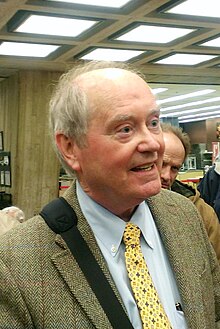Chris Quigg
Chris Quigg (born December 15, 1944 in Bainbridge ( Maryland )) is an American theoretical physicist who mainly deals with elementary particle physics.
Life
Quigg grew up in Bethlehem , Pennsylvania , and studied at Yale University ( Masters 1966). In 1970 he received his PhD with John David Jackson in Berkeley . He was then Associate Professor at the State University of New York at Stony Brook and at the University of Chicago . From 1974 he was at the Fermilab near Chicago, where he was head of the theoretical physics department from 1977 to 1987. Quigg was visiting professor a. a. at the École normal supérieure , Cornell University , Princeton University and in Vienna (Erwin Schrödinger Professor) and visiting scholar at CERN .
From 1974 to 1978 he was an Alfred P. Sloan Fellow . In 1983 he became a Fellow of the American Physical Society and he is a Fellow of the American Association for the Advancement of Science . Quigg received the Alexander von Humboldt Prize. He was editor of the Annual Review of Nuclear and Particle Science from 1994 to 2004 .
Quigg occupied himself a. a. with the physics of systems of heavy quarks (e.g. quarkonium ) and with particle physics - such as the interaction of neutrinos - at very high (“ultra-high” on the T eV scale) energies. With Benjamin Lee and HB Thacker in 1977, he gave an upper limit for the mass of the Higgs boson (from unitarity arguments for the partial wave scattering amplitudes) of 1 TeV ( Lee-Quigg-Thacker-Bound ).
Quigg was co-author of studies for the 1993 failed for financial reasons Superconducting Super Collider (SSC), in the Central Design Group, he worked from 1987 in Berkeley Deputy Director, and authored 1984 Estia Eichten , Kenneth Lane and Ian Hinchliffe the influential review article "Super Collider physics ". For this they received the Sakurai Prize in 2011 .
For the X (3872) "particle" (of mass 3.872 GeV) discovered in 2003 during the decay of B mesons (in charmonium and two pions) at the Japanese Belle experiment (at the KEKB accelerator ), he suggested an interpretation as charmonium resonance , as an alternative to explanations such as molecules from mesons with charm quarks (like D_0) or four-quark particles (tetraquarks).
He has been married since 1967 and has two children.
Fonts
- Gauge theory of the strong, weak and electromagnetic interactions. Benjamin Cummings 1983, Westview Press 1997, ISBN 0-201-32832-1 .
- with Rosner: Quantum mechanics with application to Quarkonium. In: Physics Reports , Vol. 56, 1979, pp. 167-235.
- Elementary particles and forces , Scientific American, April 1985
- Electroweak Theory . TASI Lectures, 2002, arxiv : hep-ph / 0204104v1 .
- Natures greatest puzzles . SLAC Summer Institute 2004, arxiv : hep-ph / 0502070v1 .
- Visions - the coming revolutions of particle physics . 2002, arxiv : hep-ph / 0204075v1 .
- Top-ology . In: Physics Today. 1997, extended, physics of the top quark, arxiv : hep-ph / 9704332
Web links
- Homepage at the Fermilab
- Biography at Physics Central
- Sakurai Prize for Quigg
Individual evidence
- ↑ z. B. Quigg: Cosmic Neutrinos . 2008, arxiv : 0802.0013 .
- ^ The Strength of Weak Interactions at very high energies and the Higgs Boson mass. In: Physical Review Letters , Volume 38, 1977, p. 883, and Physical Review D , 16, 1977, p. 1519
- ↑ Reviews of Modern Physics Volume 56, 1984, pp. 579-707, Erratum Volume 58, 1986, p. 1065
- ↑ confirmed by the CDF experiment at the Fermilab Result of the week at the Fermilab
- ^ Quigg: Quarkonium- New Developments. 2004, arxiv : hep-ph / 0403187v2 . Eichten, Lane, Quigg, 2004, arxiv : hep-ph / 0401210 .
| personal data | |
|---|---|
| SURNAME | Quigg, Chris |
| BRIEF DESCRIPTION | American physicist |
| DATE OF BIRTH | December 15, 1944 |
| PLACE OF BIRTH | Bainbridge, Maryland |
